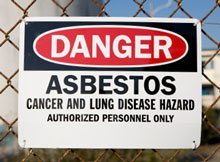Malignant Mesothelioma Risk May Eventually Plateau

The risk for developing malignant pleural mesothelioma after asbestos exposure may not increase indefinitely. Researchers in Italy say the chances of contracting the lung-related type of asbestos cancer appear to top out at about 40 years.
Unfortunately, the same is not true of peritoneal mesothelioma, which occurs in the abdomen. The risk also continues to increase for lung and ovarian cancer.
Cancer Risk from Asbestos
The study was conducted by experts in cancer, occupational medicine, and environmental epidemiology and included data from 43 previously-studied groups of asbestos-exposed individuals.
In total, there were more than 51,000 people involved in the study, including those who had worked with asbestos cement, in shipbuilding, or with asbestos in some other capacity. The health impact of their asbestos work was tracked from 1970 to 2010.
The conclusion was that the risk of developing cancer, including both major types of malignant mesothelioma, and lung-scarring asbestosis, tended to increase, rather than decrease, over time.
“Mortality was significantly increased for all deaths, all malignancies combined, pleural and peritoneal malignancies, lung and ovarian cancer, and asbestosis,” states the report, published in a recent issue of Occupational and Environmental Medicine.
Pleural Mesothelioma Rates Stop Increasing
Once inhaled or swallowed, asbestos fibers bury themselves deep in the tissue and are nearly impossible for the body to get rid of. Over time, the irritation and inflammation they cause can trigger malignant changes at the cellular level that cause malignant mesothelioma and other cancers.
In the case of mesothelioma, the time between exposure and disease development (the latency period) can last 50 years or more and is one of the longest of any cancer. But the Italian report suggests that, at least in the case of pleural mesothelioma, latency may not be indefinite.
Their figures found that the rate of pleural mesothelioma among the studied workers tended to increase during the first 40 years after initial exposure but then plateaued.
Two other types of cancer that have also been associated with asbestos exposure – cancer of the larynx and digestive tract cancer – did not increase over time.
Cancer rates among the asbestos workers were calculated using typical rates in the general population as a reference.
Malignant mesothelioma is the only cancer associated almost exclusively with asbestos exposure. Most malignant mesothelioma patients contracted the disease because of on-the-job exposure to this carcinogen.
Source:
Farrante, D, et al, “Italian pool of asbestos workers cohorts: mortality trends of asbestos-related neoplasms after long time since first exposure”, August 3, 2017, Occupational and Environmental Medicine, Epub ahead of print





